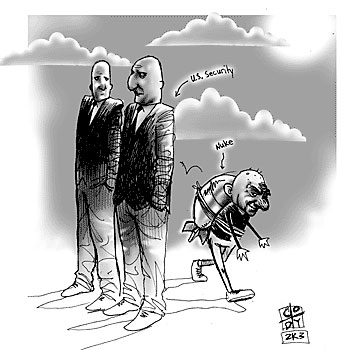
Illustration by Cody Angell
|
|
By Ryan Scalise
Arizona Daily Wildcat
Tuesday, November 25, 2003
Print this
Last summer I had the opportunity to be a research assistant for the Analytic Services Institute for Homeland Security. Most of my research involved threat and vulnerability assessments in the event of biological terrorism or other sorts of attacks. The major case study we used was on the anthrax attacks of 2001, which followed shortly after Sept. 11's terrorist attacks.
In analyzing the governments' response to the anthrax attacks, our team concluded that our country ÷ federal, state and municipal ÷ was completely caught off-guard and was incapable of handling this situation in a coherent way. The report can be found at http://www.homelandsecurity.org/bulletin/Anthrax202001.pdf.
Essentially, during the attacks, fear and panic set in and no one was communicating. The federal body for dealing with this sort of emergency ÷ the Center for Disease Control and Prevention ÷ was incapacitated and unprepared to coordinate and pass information down to the state and local levels of public health and disaster management agencies. What's more important is that this report concluded that our nation is still severely unprepared ÷ hence the reason for all of these "emergency and readiness" drills.
On Nov. 17, the U.S. and Mexican governments participated in a mock terrorist chemical weapons attack at the Nogales-Mariposa point of entry. The Arizona Republic reported that this simulation included a suicide bomber who blew himself up, triggering a truck to explode and releasing chlorine gas that contaminated the area and caused casualties. The same publication also reported that one of the central problems with the drill involved communication ÷ especially the dissemination of warnings.
The reason for doing these drills in Southern Arizona is that the ports of entry in Nogales and Douglas are vital to trade; the American, Mexican and Canadian economies; and the global economic world order. If an attack like the one simulated ever came to fruition, the flow of goods and services in these points of entry would be shut down ÷ perhaps permanently.
If the government does not step up its efforts to be prepared, people will generally lose confidence in the government's ability to keep them safe, which will only further destabilize our way of life.
Being prepared and vigilant is hard to do for long periods of time. For instance, the World Trade Center was attacked in 1993 by a member of al-Qaeda ÷ Ramzi Yousef. This attempt included a truck bomb ÷ they hoped to collapse both buildings and then they wanted to finish it off with a cyanide gas. This attempt failed, but al-Qaeda waited eight years to try it again ÷ all the while measuring our reactions and responses. Eventually we dropped our guard and they exploited the gaps in our security in ways that we never could have dreamed. Accordingly, we need sustainable vigilance and preparedness, which means more drills will occur from time to time. If you are annoyed by this or feel as if they are a waste, just remember those people who died on Sept. 11 and those who died from inhalation anthrax.
These drills are important for many reasons and should be taken seriously because the military found plans and instructions for conducting a biological weapons attack ÷ among other nefarious, methodical and sophisticated strike capabilities ÷ in the al-Qaeda training manual in the hills of Afghanistan.
One of the reasons for this strong effort for preparing and responding to a chemical or biological attack is to create a deterrent to such a strike. The logic is as follows: If we make an effort to have our public health officials ready and there is a coordinated effort to deal with a potential attack, it will diminish the loss of life and limit damage, effectively thwarting the terrorist's aims of creating fear, panic and senseless death.
Drills are completely necessary and will continue to occur. Perhaps the drills should move away from what are traditionally considered to be our vulnerabilities ÷ such as mass transportation ÷ to areas that are usually not thought of as threats. After all, no one expected that al-Qaeda would use Boeing jets as weapons. Drills will help our security officials be more prepared, but the fact remains that terrorism is largely unpredictable and, try as we may, another attack is likely to occur. And if it does, we must be prepared.
Ryan Scalise is a political science senior. He can be reached at letters@wildcat.arizona.edu.
